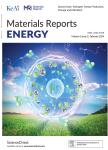Valence state effect of Cu on photocatalytic CO_(2)reduction
作者机构:School of PharmacyJining Medical UniversityRizhao276800PR China Key Laboratory of Eco-chemical EngineeringMinistry of EducationCollege of Chemistry and Molecular EngineeringQingdao University of Science and TechnologyQingdao266042PR China College of Sino-German Science and TechnologyQingdao University of Science&TechnologyQingdao266042PR China College of Materials Science and EngineeringQingdao University of Science and TechnologyQingdao266042PR China College of Environment and Safety EngineeringQingdao University of Science and TechnologyShandong Engineering Research Center for Marine Environment Corrosion and Safety ProtectionQingdao266042PR China
出 版 物:《Materials Reports(Energy)》 (材料导报(能源)(英文))
年 卷 期:2023年第3卷第4期
页 面:39-45页
核心收录:
学科分类:081704[工学-应用化学] 07[理学] 070304[理学-物理化学(含∶化学物理)] 08[工学] 0817[工学-化学工程与技术] 0703[理学-化学]
基 金:supported by the National Natural Science Foundation of China(51802171,52072197) Youth Innovation and Technology Foundation of Shandong Higher Education Institutions,China(2019KJC004) Major Scientific and Technological Innovation Project(2019JZZY020405)
主 题:Valence state Cu Photocatalytic CO_(2)reduction
摘 要:Copper(Cu)is extensively employed in photocatalytic CO_(2)reduction reactions for the production of high-value *** valence state of transition metals plays a pivotal role in influencing the catalytic ***,due to the complex valence state changes of Cu in the CO_(2)reduction reaction,research on its valence state effect is *** current work is to prepare a series of TiO_(2)/CuX with stable Cu valence composition using different copper halides(CuX and CuX_(2),X=Br or Cl)as *** results show that the CuBr_(2)loading leads to Cu^(+)/Cu^(2+) mixed cocatalyst and exhibits the highest activity for CO_(2)*** CH4 evolution rate of the TiO_(2)/CuBr_(2)catalyst is as high as 100.59μmol h^(-1)g^(-1),which is 6.6 times that of pristine TiO_(2).The CH4 selectivity reaches 77%.The enhanced catalytic activity and selectivity can be ascribed to the efficient surface adsorption,activation,excellent carrier separation,and transfer ofCu^(+)/Cu^(2+) mixed *** findings provide a reference for designing highly active Cu-based photocatalysts.



